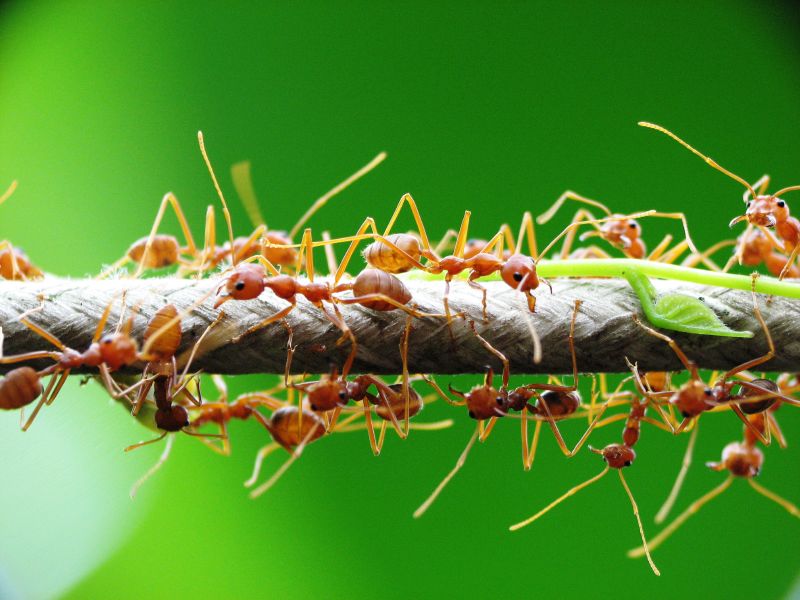30 September 2024
– Mohit Nikalje
Mountains are home to 85% of the world’s amphibian, bird, and mammalian species, despite covering only 25% of the Earth’s surface. This makes them a highly diverse ecosystem and a key focus for conservation efforts.
In mountainous regions, species diversity – the measure of how many different species are present – can vary with elevation due to environmental factors like climatic conditions. However, a recent study from the Centre for Ecological Sciences (CES), Indian Institute of Science (IISc) has uncovered a different factor driving bird species diversity at mid-elevations: the presence of ants from the Oecophylla genus.
“In mountains, you often see hump-shaped patterns [of species diversity], and for a long time, people have been interested in why this happens. One of the mechanisms they did not think much about was biotic interactions like competition,” says Kartik Shanker, Professor at CES and co-author of the study published in Ecology Letters.
Oecophylla ants, known for their aggressive and dominant behaviour, are voracious predators of insects at the bases of mountains found in the paleotropics, covering Africa, Asia and Oceania. The researchers decided to test how the ants’ presence affects the diversity of insect-eating birds, especially at lower elevations.

Weaver ants (Oecophylla smaragdina) (Photo courtesy: Tuan Cao/Wikimedia Commons)
A previous study led by co-author Trevor D Price, Professor at the Department of Ecology and Evolution, University of Chicago, showed that the presence of Oecophylla ants at the base of the eastern Himalayas decreased the density of insects and might therefore have an effect on the presence of insect-eating birds. In the current study, the team wanted to see if this pattern was more widespread among other insect-eating species as well.
Led by Umesh Srinivasan, Assistant Professor at CES, the researchers used existing datasets with information about bird species observed at various elevations across different mountain ranges. They categorised the birds into dietary guilds – groups of species with similar dietary requirements, such as insectivores and omnivores.
“We looked at the ranges of these bird species. We noted what bird species [in each guild] occurred at 100 metres, then 200, 300 and so on, for every 100 metres,” explains Srinivasan. “We then classified mountain ranges with or without Oecophylla at the base, and looked at what species were present at different elevations.”
The researchers found patterns consistent with Oecophylla ants competing with insect-eating birds for food at lower elevations. This could then have ended up pushing these birds higher up in the mountains – the species diversity was highest at an elevation of about 960 metres. Other bird groups like nectar-eating and fruit-eating birds – which weren’t competing with Oecophylla ants – reduced in species diversity as the elevation increased. The presence or absence of Oecophylla ants at the base of mountains, therefore, was a good predictor of why the diversity of insect-eating birds peaked at mid-elevations, the team found.
“With climate change, if the ants shift their ranges towards higher elevations, this might impact the bird species at higher elevations as well,” adds Srinivasan.
REFERENCE:
Srinivasan U, Shanker K, Price TD, Ant impacts on global patterns of bird elevational diversity, Ecology Letters (2024).
CONTACT:
Umesh Srinivasan
Assistant Professor, Centre for Ecological Sciences (CES)
Indian Institute of Science (IISc)
Email: umeshs@iisc.ac.in
Phone: 080-22932360
Website: https://ces.iisc.ac.in/?q=user/408
Kartik Shanker
Professor and Chair, Centre for Ecological Sciences (CES)
Indian Institute of Science (IISc)
Email: kshanker@iisc.ac.in
Phone: 080-22933104
Website: http://www.kartikshanker.in/
NOTE TO JOURNALISTS:
a) If any of the text in this release is reproduced verbatim, please credit the IISc press release.
b) For any queries about IISc press releases, please write to news@iisc.ac.in or pro@iisc.ac.in.


